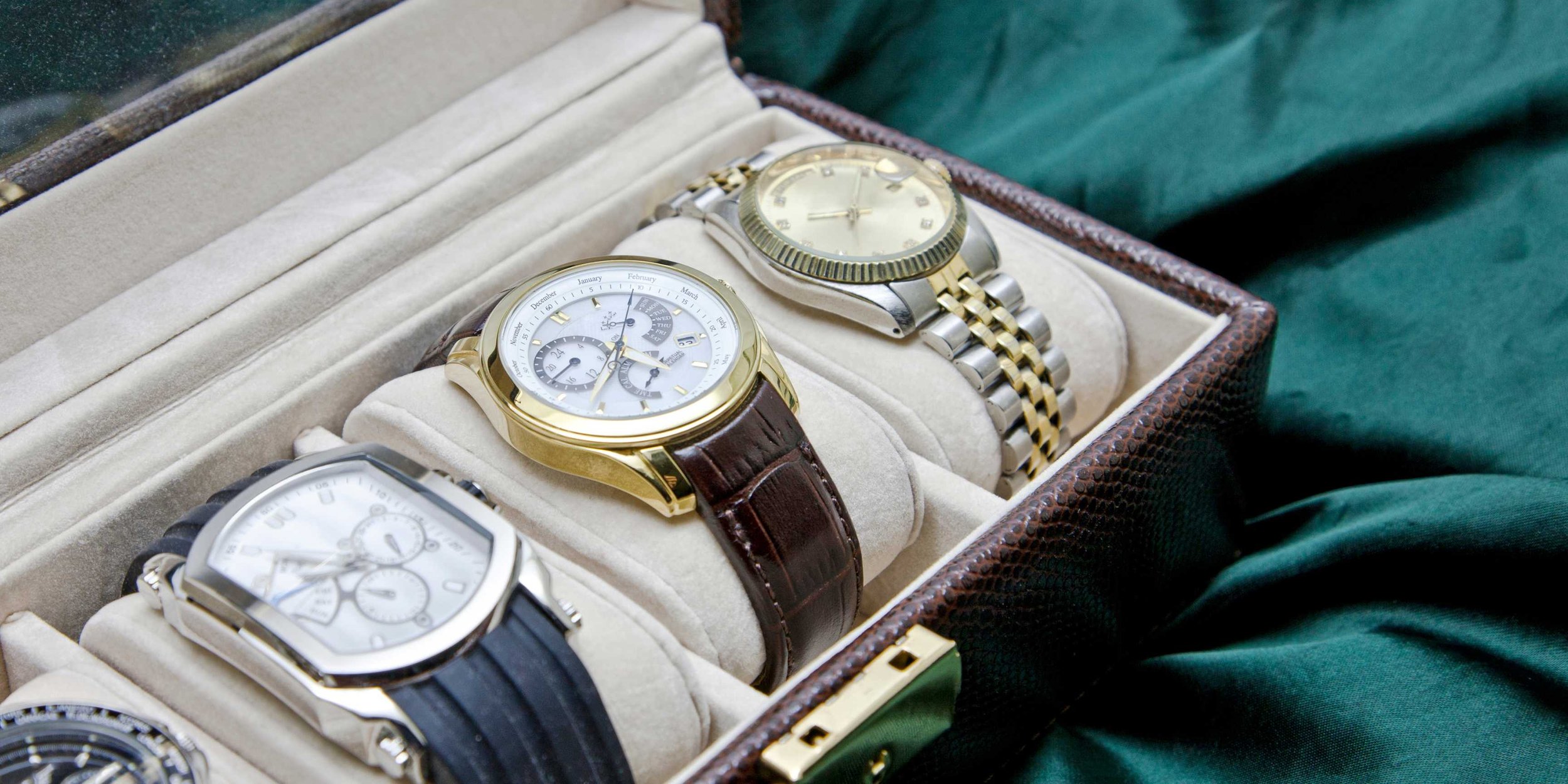Watchmaker’s Guide: Choosing Between Acrylic, Mineral & Sapphire Crystals
Last updated June 2025 by Huxley Mann.
When it comes to watches, the movement may be the heart, but the glass is the face. Whether you're a collector, a casual enthusiast, or a professional watchmaker, understanding the various types of watch glass (also known as watch crystals) is crucial for both functionality and aesthetic appeal. From scratch-prone acrylic to ultra-durable sapphire, the material you choose affects not only the look of a timepiece but also its longevity, resistance to damage, and overall value.
In this guide, we’ll explore the three most common types of watch glass — acrylic, mineral, and sapphire — and their unique properties, advantages, and best-use scenarios. Whether you're replacing a damaged crystal, looking for an upgrade, or simply curious about the different glass types that protect your dial, at AMJ, we've paired up with our expert watchmakers to explore what sets each material apart — so you can make the right choice for your timepiece with confidence.
A Brief History of Watch Crystals
The watch crystal—the transparent cover that protects the watch dial—has evolved significantly over the centuries, in tandem with watchmaking itself.
In the 18th and 19th centuries, early watches were fitted with natural glass or blown mineral glass, which was fragile and prone to scratching or cracking. As pocket watches transitioned into wristwatches in the early 20th century, durability became increasingly important, prompting watchmakers to seek stronger, more resilient materials to withstand daily wear and exposure to the elements.
To meet the growing demand for stronger materials, manufacturers began using acrylic (also known as plexiglass) during the 1930s and 1940s, particularly in military applications, due to its lightweight and shatter-resistant properties.
By the 1960s and 1970s, mineral glass — a tempered, more scratch-resistant type of glass — became the industry standard for many mid-range watches, offering better clarity and strength than acrylic.
The most significant leap came in the early 20th century with the invention of synthetic sapphire crystal by French chemist Auguste Verneuil in 1902. Initially used in jewellery, synthetic sapphire was adopted by luxury watchmakers like Rolex and Omega in the 1970s and 80s for its near-scratchproof properties and crystal-clear appearance. Today, sapphire glass is considered the premium choice in the watchmaking industry.
From fragile glass to nearly indestructible synthetic sapphire, the history of watch crystals reflects the ongoing innovation in horology, combining tradition, technology, and aesthetics.
What Are the Different Types of Watch Glasses?
When it comes to replacing the glass on your watch, understanding the differences between acrylic, mineral, and sapphire watch crystals is key to choosing the right option for your needs and budget. Each material varies in durability, cost, appearance, and scratch resistance.
Let’s break down the three main types of watch glasses to help you make an informed decision:
Acrylic Watch Glasses: Affordable and Lightweight Plastic Crystals for Watches
Acrylic watch glass, also known as plastic crystal, is a standard material used in many watches due to its lightweight and budget-friendly nature. This type of watch glass is easy to replace and is available in a variety of colours and styles, making it especially popular for fashion watches and entry-level timepieces.
However, acrylic watch crystals are more susceptible to scratches and wear compared to more durable options, such as mineral glass or sapphire crystal. While acrylic offers excellent versatility and affordability, its lower scratch resistance means it may need more frequent replacement.
Mineral Watch Glasses: Durable and Clear Protection for Everyday Wear
Mineral watch glass is a popular choice for many mid-range to high-end watches due to its excellent balance of durability, clarity, and affordability. Made from tempered glass, mineral crystals undergo a heat-tempering process that strengthens their surface, significantly increasing resistance to scratches and shattering compared to standard glass.
While mineral glass is slightly more expensive than acrylic, it offers superior protection against everyday wear and tear, making it an ideal replacement option for watches that require regular use. Its clear, polished surface also enhances dial visibility, adding to the overall aesthetic appeal of your timepiece.
Sapphire Watch Glasses: The Premium, Scratch-Resistant Crystal
Synthetic sapphire watch glass has been a game-changer in watchmaking since its invention in 1902 by Auguste Verneuil, who developed a method to create lab-grown sapphire crystals by melting powdered aluminium oxide with an oxyhydrogen flame and crystallising the droplets.
Today, sapphire crystals are the standard for luxury watch brands such as Rolex, Patek Philippe, Hublot, and Omega, due to their exceptional hardness and clarity. Cut from a single sapphire crystal and polished to precise dimensions, sapphire watch glasses rate a 9 out of 10 on the Mohs hardness scale, making them exceptionally resistant to scratches and abrasions.
Besides their impressive durability, sapphire crystals provide unparalleled optical clarity and a brilliant reflective sheen that enhances the elegance and readability of any watch dial. Although more costly than acrylic or mineral glass, sapphire watch glass is a worthwhile investment for protecting high-end timepieces.
What to Do If You Break Your Watch Glass
If you accidentally break your watch glass (also known as the watch crystal), it’s essential to act quickly and take your timepiece to a qualified watch repair technician as soon as possible. A prompt, professional assessment can prevent further damage and ensure the best repair outcome.
A skilled watchmaker will carefully examine the extent of the damage to determine whether the glass can be repaired using adhesives or if a complete replacement of the watch glass is necessary. If replacement is required, the technician will recommend and install a high-quality crystal that precisely matches your watch’s model and specifications, whether it’s made of acrylic, mineral, or sapphire glass.
In cases where the watch glass shatters completely, it’s crucial to immediately stop the movement by pulling out the watch’s crown to prevent any tiny shards of glass from getting caught in the moving hands, which could scratch the dial or bend the delicate watch hands.
Depending on the severity of the breakage, your watch may also need a thorough service to remove any glass fragments that may have infiltrated the internal mechanism, safeguarding your timepiece from further internal damage.
How to Differentiate Between the Different Types of Watch Crystals
Knowing the type of watch crystal protecting your timepiece is essential for choosing the right replacement. Here are key ways to identify the three main types of watch glass: acrylic, mineral, and sapphire.
1. Acrylic Watch Crystal
Appearance: Often has a slightly warmer or softer look compared to glass; can be domed or flat.
Feel: Feels softer and less cold to the touch than glass.
2. Mineral Glass Crystal
Smooth and Glassy: Mineral glass feels smooth and cool to the touch, much like regular glass, such as a smartphone screen.
Slightly Less Slick: Compared to sapphire, mineral glass can feel less slick or glossy, sometimes with a subtle matte finish, depending on the watch.
3. Sapphire Crystal
Ultra-Smooth and Luxurious: Sapphire crystal feels incredibly smooth and almost glass-like but has a noticeably higher gloss and polish.
Cold and Solid: It has a cool, solid feel, and it’s denser and heavier than mineral glass.
Quick Tip:
If you’re unsure, a professional watch repair company can easily identify the crystal type using specialised tools and tests to ensure proper care and repair.
Does a New Watch Crystal Mean You Must Perform a Pressure Test?
If your watch is water resistant, it is essential to have a pressure test performed after replacing the watch glass. This test ensures your timepiece still meets the manufacturer’s water resistance specifications, preventing water from entering the case.
Pressure testing verifies the integrity of the new crystal installation and checks for potential issues with the watch’s movement, seals, and gaskets. Detecting these problems early allows for timely repairs, helping you avoid costly damage caused by moisture or water ingress.
How Much Does It Cost to Replace the Glass on a Watch?
The cost to replace a watch glass varies based on several important factors, including the type of crystal (acrylic, mineral, or sapphire), the size and shape of the glass, the watch brand, the model, and whether your timepiece requires pressure testing and new seals to maintain its water resistance.
Acrylic or mineral glass replacement typically costs £25 to £50, making it affordable for most everyday watches.
Sapphire crystal replacement, due to its premium quality and durability, can cost up to £150 or more.
Replacement costs can be significantly higher for vintage watches. Many older models may no longer have standard glass replacements available, meaning a custom-cut bespoke watch crystal must be made to fit. This specialised service can easily cost several hundred pounds, depending on the complexity and rarity of the glass required.
Which Watch Crystal Is Best for You? Acrylic vs Mineral vs Sapphire
Choosing the right watch crystal depends mainly on your lifestyle, budget, and how you use your timepiece. Here’s a quick guide to help you decide between acrylic, mineral, and sapphire crystals:
Acrylic Watch Crystal: Acrylic crystals for those who value an affordable, lightweight option that’s easy to polish and restore. They offer flexibility but require more care due to their lower scratch resistance.
Mineral Glass Crystal: A versatile choice, mineral glass offers solid durability and superior scratch resistance compared to acrylic, making it a popular and cost-effective option for everyday wear without compromising style.
Sapphire Watch Crystal: Sapphire crystal is a premium choice for luxury watch owners who demand superior scratch resistance, unmatched clarity, and that all-important luxurious finish. Although it comes at a higher price point, it offers long-lasting protection for high-end or frequently worn watches.
Ready to Choose the Perfect Watch Crystal for Your Timepiece?
Elevate your timepiece today—visit AMJ Watch Repair in London’s historic Jewellery Quarter for a one-on-one consultation with our watchmakers. Whether you’re upgrading to sapphire, swapping in polished mineral glass, or refreshing with acrylic, we’ll fit the perfect crystal to suit your style, budget and lifestyle. Feel free to visit our watch repair centre in person or contact us directly to explore the various options.


